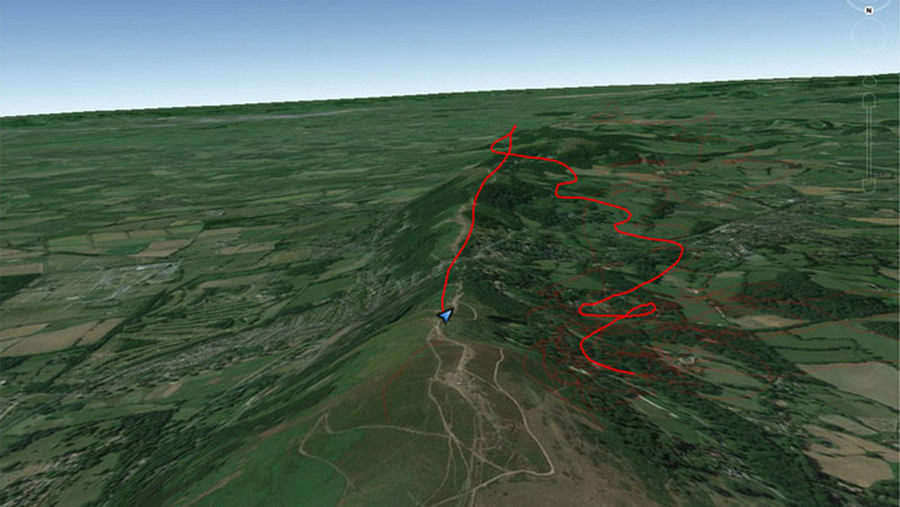
When flying a spine-backed ridge in strong conditions, an experienced pilot suffered a wing collapse with a cravat and decided to deploy his reserve. He was blown over the crest of the ridge and landed hard. In this detailed analysis he shares the background and lessons of what he considers to be a lucky escape.
The background
I got my wing before the start of the 2011 season. So far this year I had logged 14 hours (about 900 hours in total, with approx 135 of those on the current glider). I fly at the top of the weight range.
I'd had one prior reserve deployment, nearly 20 years ago, during that incident I compacted a vertebra in my spine. Since then only the occasional aborted take-off or the occasional dodgy landing.
Over the last four years I would often fly in more marginal conditions trying to make the most out of the few opportunities I had to fly. Although I was never massively current I felt I had a wealth of experience to draw on and that experience would keep me safe.
I have only had one significant collapse on the glider before this event, a couple of large asymmetric collapses sure, but they were always fairly benign. This 'big' one was back in 2012 whilst flying abroad at a competition, I lost sight of the glider during an unexpected frontal but it came back clean and I was able to fly away.
I have had some frontals (certainly no more than three) on the glider too but they were well 'signposted' and it was really just the big asymmetrics that would 'surprise' but they were easy to deal with. I felt fully capable of handling this type of glider.
The build-up
In the two weeks prior to the accident I had logged 5 hours paragliding, as well as 2 hours in a sailplane. The PG hours were including two XCs (80km total) and, although I'd said to others that I felt out of practice at flying XCs, on the day itself I was cautious yet confident, having flown 50km in what I considered to be marginal conditions only the day before.
On the day itself my friends and I had a 5 hour journey to arrive at the site and were approx 1 hour later than planned, we discussed the possibility of tasks on the walk up. We were all looking to fly XC and I had provisionally declared Dunstable for 126km (more than double my previous UK best).
The weather
The forecast was for stronger than average PG flying winds, RASP indicated the winds would be slightly lighter in the Shropshire area than they were in Wiltshire, archive screen shots follow on the next pages. Wave was not forecast but lenticular clouds, aligned with an upper NW wind, were seen and the day had blued out with only small cu briefly forming. It looked reasonable and I intended to leave the hill at no less than 3,000 ft AMSL and to fly the first downwind part as fast as possible when I had stopped climbing. I figured on clearing 10km as a minimum before searching for another climb.
.jpg)
^ Take off time and intended flight
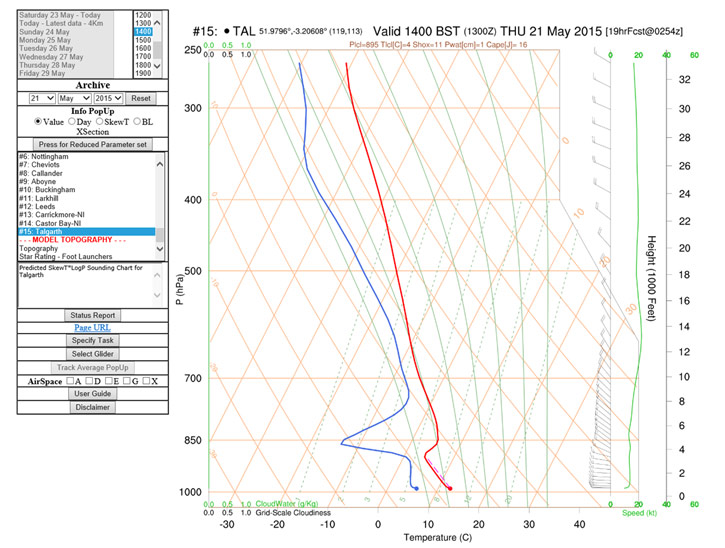
^ Tephi from Talgarth approx 50km upwind
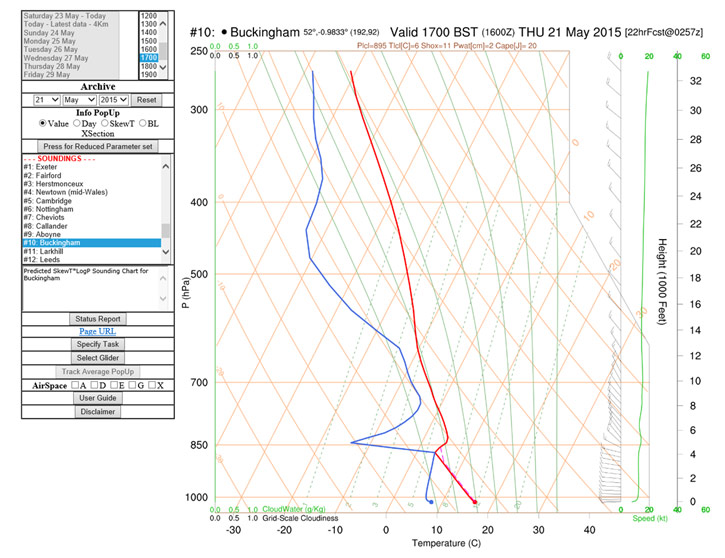
^ I expected to be near Buckingham at 80km in around three hours
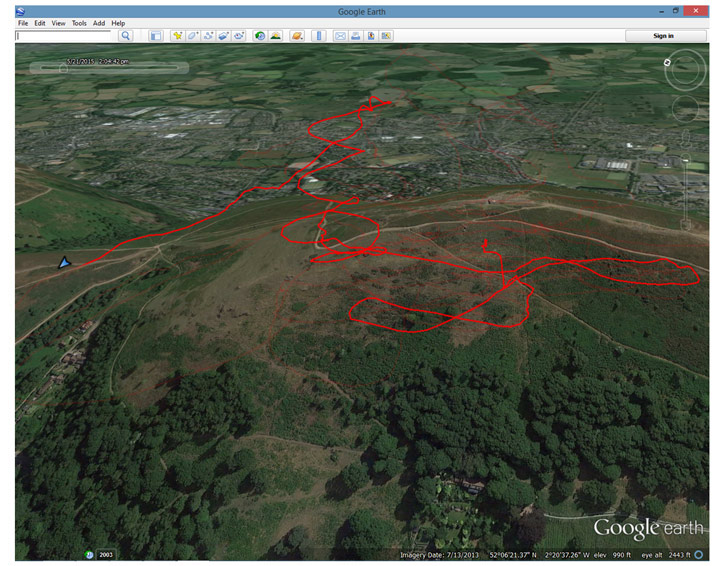
^ Launch and the first five minutes, here I am 500m WNW of the trig point and 100m above
After approx 15 mins in the air the first of my two friends launched as I found my first good climb, he failed to connect and sank out. Despite climbing well I elected not to go XC at this time in order to be certain he got down safely. During this time my 2nd friend launched and he headed straight out to the WNW and started working climbs on the other side of the town, well away from the hill.
After another 10 mins he too was sinking out and headed for landing, at this point I connected with the strongest climb yet. I had had approx half an hour in the air and was more relaxed, I felt conditions were not as marginal as we'd first thought and certainly much more mild than they had been on the previous day. The climbs were requiring a constant upwind adjustment of 360 and as I widened the turn I encountered the collapse. The GPS trace shows I was further back than I had been previously but also higher and not yet fully over the back of the hill.
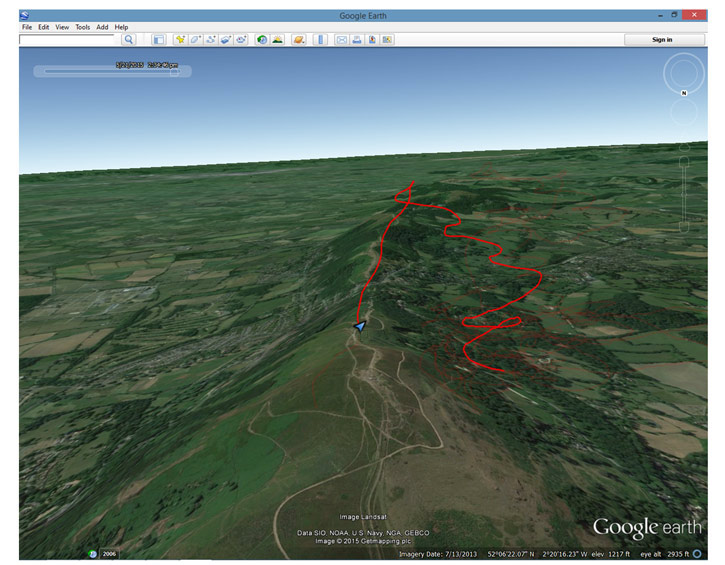
^ Just prior to reserve throw
As I straightened into wind the glider went 'phwhumph' and I went to freefall, I immediately went brakes up and looked for the wing and saw it to my left rear headed away from me rotating left with approx 30 to 50 % cravatte in the left side. As the tension came back I got a half twist kick to the right and buried the right brake to halt the rotation. I managed to keep the glider straight and away from the hill whilst untwisting but could not prevent a second slow turn. At this point I gave up trying to recover as I was passing over the brow of the hill and rapidly losing height (I figured approx half of what I had had gone). I threw my reserve.
· The collapse occurred at 14:34:26
· Twenty seconds later the reserve was out and inflated
· I arrived on the ground at 14:35:03 having lost 24m in the preceeding 3 seconds
Deployment to impact, approx 17seconds and 125m
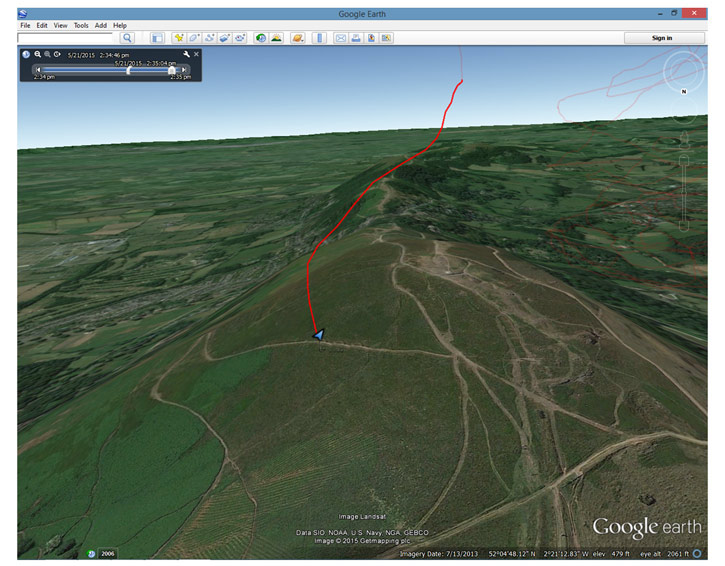
^ Reserve ride
I think this shows drifting with the wind until I hit the sink behind the hill, the last three seconds before impact indicate 7m, 10m and 7m height loss the final second shows a 3m height loss but I feel this is averaged... I don't think I hit the ground at 3m per second.
Without the reserve I feel I would have spiralled in to the crest of the hill or just behind at something approaching 12m/s, throwing earlier might have given me more chance to limit down-planing but then it might have exposed me to buildings or trees and we enter the realms of what-ifs. I believe I had the wing largely depowered before impact but no-one saw me hit the ground. Due to the rotations I cannot say for sure what state the main was in but I know the reserve was fully deployed and I had pulled in at least 1.5m of right brake line. The impact was almost certainly exacerbated by the curl-over behind the hill.
I was in a PLF position when I hit the ground, I exhaled deeply before impact and hit feet first then knees and hips all on my left side. I had an immediate and intense pain in my left hip and I had arrived at a dead stop with no kind of roll or bounce to dissipate the energy. I was awake and alert throughout and had no nausea or symptoms of shock, I was able to move hands and feet and only experienced pain in my left hip and groin.
I was fairly certain I was just bruised but when assisted to stand by passers-by I could not take a step forward with my left leg. I had delayed them calling the emergency services believing that in a few minutes I would be able to walk at the very least. I took my own painkillers and had some water whilst we waited.
Aftermath
Once the emergency services were summoned there was some delay in locating me, I could only provide Lat / Long co-ordinates from my GPS and the ambulance service wanted a road name.
There were a few roads available to be chosen but the operator was from another service and could not say which direction the local ambulance service response would come from. We (myself and the passers-by who came to my aid) were unsure what to recommend as we did not know what kind of response was being dispatched, or what kind of equipment for extrication they would bring, and the operator couldn't tell me either as she was from another service.
The first emergency response to arrive on scene were the Fire brigade who arrived with an All Terrain Vehicle. The helicopter medics were close behind and it was agreed the Fire brigade could transport me to me an ambulance and I would be taken by road to a trauma centre.
Upon arrival at Worcester Royal I was X-rayed twice and then discharged with painkillers after approx 4 hours, I had been kept flat for a long time in the hospital and was getting increasingly sore and stiff. I was driven home by my friends.
The next morning I received a call from the hospital asking me to return for assessment and it was arranged for me to be reviewed locally (as I don't live in Worcester). The subsequent review confirmed I had a stable fracture that would not require surgery. The only change to my treatment would be regular follow up with the fracture clinic and a period of 6 - 8 weeks to heal and recover as opposed to the initial guidance of 2 - 4 weeks for a muscular injury.
Conclusions
Turbulent air caused a violent collapse which could not be recovered. The reserve was used in good time and was fully deployed before impact. The impact caused a fracture of a part of the pelvis but it is stable and a full recovery is expected without the need for surgical intervention within 6-8 weeks.
Considerations
Harness: a lightweight pod style harness. The in-flight position is with legs extended increasing the chance of rotation due to inertial lag between wing and pilot. Perhaps I could have tucked my legs in sooner, I was rotating with the wing for the second rotation and only became twisted again during reserve deployment. The reserve was attached at the main carabiners and was deployed successfully at the first attempt. There is no certified or approved back protector for the harness but impact was on the side, the two plastic bottles under the seat remained intact and no foam or airbag would have changed the outcome.
Reserve: a lightweight PDA style reserve, four years old and never deployed. It was regularly repacked every 6 months, inspected and packed annually by a BHPA certified re-packer. Last open fully and repacked in December 2014. The rubber bands were changed by me in January 2015 as part of an incident report raised by the certified packer.
Glider: a high performance paraglider with EN-D certification. It is my view that any glider would have suffered the collapse but it is possible a lower aspect wing may have given a better chance of recovery by virtue of not being in a state of cravatte.
Weather: I think a combination of factors contributed to the severe turbulence, being thermal, lee side thermal, inversion and possibly wave rotor.
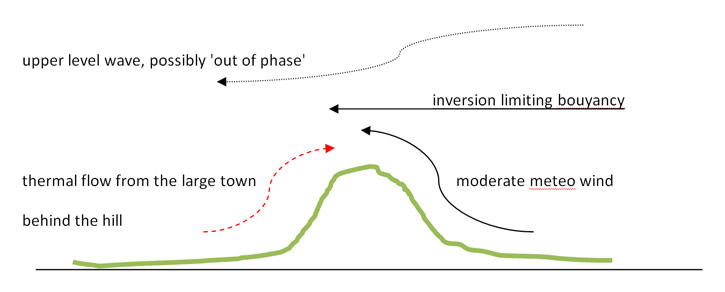
Pilot: I have 900 hours airtime and was active in the sport at its infancy through to the mid 90's when I was competing at a national level. I am AP rated for paragliders, a current coach and a team pilot for Flybubble.
The biggest contributory factor, I feel, is my willingness to fly in marginal conditions brought about by my reduced opportunity to fly. Some pilots may elect to wait for tomorrow as today looks duff, whereas for me it's often been ages since I flew and my next chance might well be a month away.
Due to poor weather over the winter and commitments from family and work I had less airtime this year than at this stage last year (approximately half). I was anxious to put in a good distance for the XC league whilst I had the chance to fly XC, an opportunity I had not had for nearly three years.
I had flown a reasonable distance in poor conditions on the previous day and I failed to consider the effects of the low inversion and wave systems, together with the terrain and the warnings from the site guide. I was overconfident and made several errors of judgement. Fortune has given me the chance to reflect and write this.
I am very grateful to
· John Martin for the repack
· Dave, Bryan and Ian from the Malvern club
· Bridget and the passers-by for the help on the hill
· Cosmin and Purna for recovering my kit and my car, staying with me in the hospital and getting me home
· The combined emergency services and staff at the Worcester Royal
and of course all of those pilots from the local clubs who have expressed concern for my well being.
I am very, very lucky to have come off so lightly from this.
